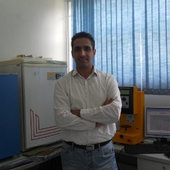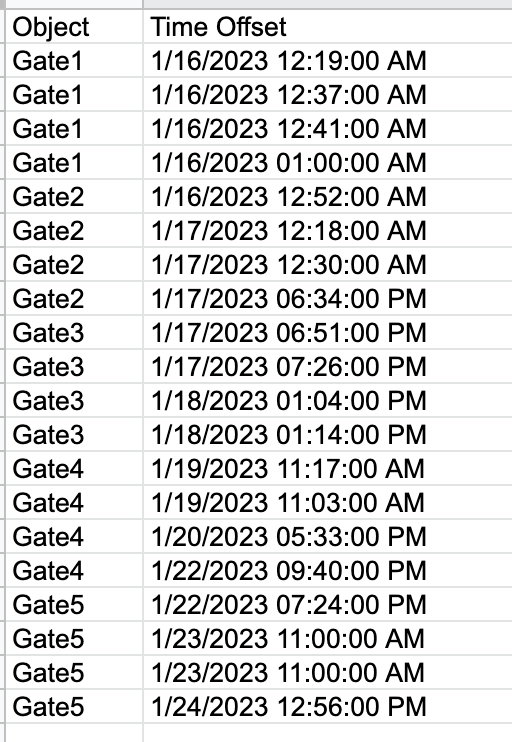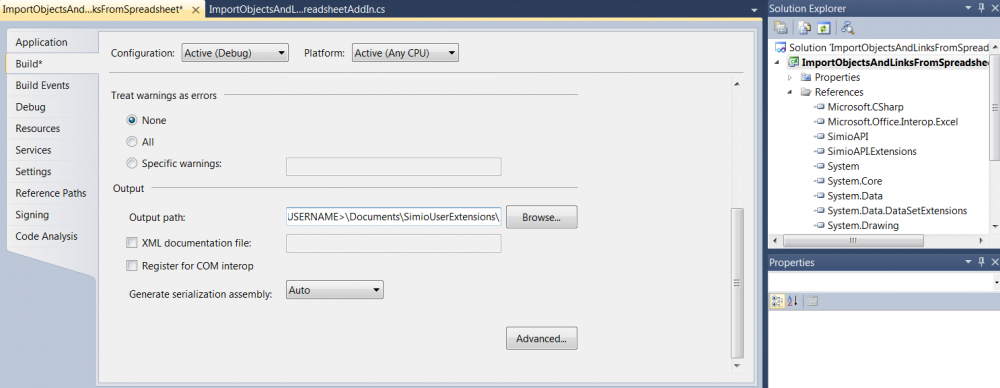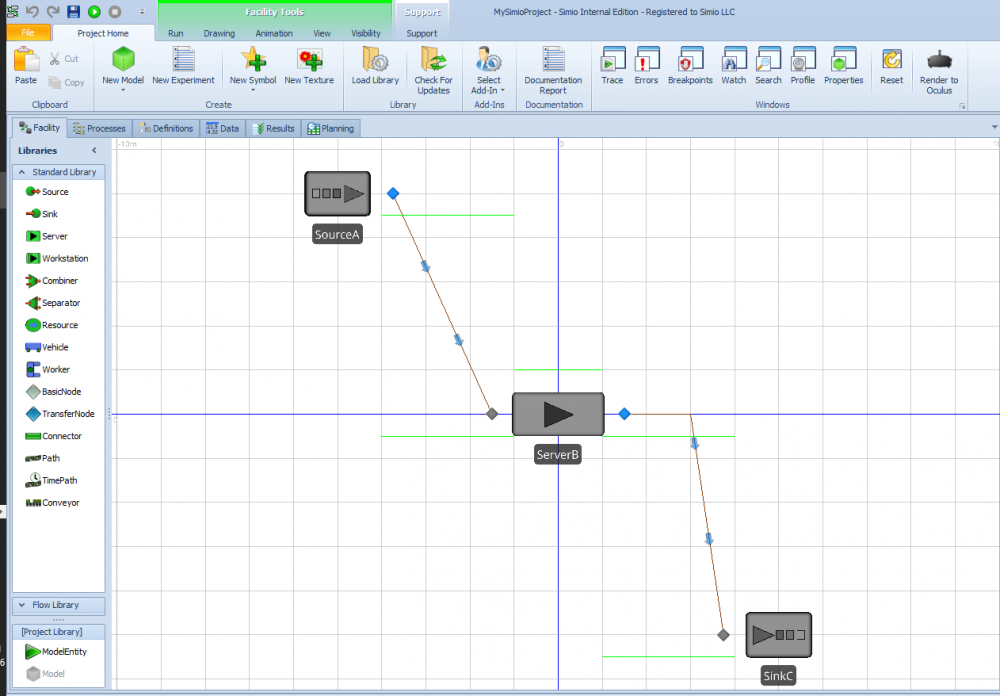Search the Community
Showing results for 'source objects disappear'.
-
Hello everyone: I am modeling a packaging system by means of a combiner. 12 equal members are grouped in a box (parent). Before leaving the respective source, members are assigned a value (0, 1, 2) as a state variable (ESV_P) to distinguish them by product type. I want the box to have the value of the products state variable. For example, if the box contains 12 type 1 products, the box should be assigned with a state variable ESV_B equal to 1. Any suggestions? Best regards.
-
Hi, I want to generate one type of product with one interarrival time. I have one source and one model entity. However, this entity can have different lengths following probabilities. Depending on these properties, the processing times at the servers will be shorter or longer. I tried to assign a state to the entity before this entity exits the source so ModelEntity.Length becomes DataLength.prob.randomrow. where DataLength is a table with the different lengths and the probabilities associated with those Lengths. The only thing is that it is a property and not a state, but I do not know how to do it in another way. Afterwards, I have different processing times at the servers depending on the different characteristics of my entity. For example, server1 will have different processing times depending on the length. How can I reference to the good processing time say I have added a column to the table DataLength with the associated processingtimes according to the lengths? Finally, I would also like keep track of those different lengths generated and see what the model produced in the end. Thank you for your help, Emilie
-
Hi Guys, I have a source producing the entities, which is processed by the server with a worker. server and worker are assigned to work schedule (7Hrs) (12am-7am) arrival model of the server is set to time varying arrival rate. to control the source on holidays. But with current scenario the source is producing the entities on off-shift time. Please help out with a logic, so that source is produces the entities matching to the timings of work schedule. Note: Simulation run is for a period of 1 year. Regards, Alen
-
Simio has a number of enabling features that are not widely known. When you save a project file, most people use the .spfx extension which is a compressed binary file. But if you would like to take advantage of a version control software (VCS), you generally want the VCS to manage versioning and file compares and file compression, itself. Simio has a multi-file project format referred to with a .simproj extension, which is designed with exactly that purpose in mind. Ths format involves a single key simproj file and a related set of folders that contains the uncompressed version of all the included components. This allows VCS to recognize when a small change to your model is made that it only needs to save that small change and not the entire model. While this works with any VCS, internally at Simio we use Tortoise SVN (http://tortoisesvn.net/) which works quite well for us. Simio also has some built-in features to help track and maintain model/library versions. If you right-click on an object (a model) and select "Properties" you will see a set of model properties for that object including Version. This version number is referenced when loading this object as part of a library to help evaluate if an object has been changed and if the change should be accepted (more on this below). Some additional model properties including Description, Keywords, and Categories. These are available in your model, plus they are available externally. For example the Sample SimBit Solutions interface uses these properties to help you quickly find a SimBit of interest. Some of them are also used in the Model Documentation Report. Speaking of which, the Model Documentation Report is designed to provide a quick way of examining all non-default parameters in your project. It can be useful to instructors evaluating assignments or as a way to record or share a snapshot of your model data. If you click on your Project name in the navigation window, the click on Models and the Edit ribbon you will see various options for subclassing, cloning, and copying library objects. These options, while subtle, give you greater control over how the lineage of an object wil be handled. You will also see options on this ribbon to protect your object from viewing and editing, and also to describe changes that have been made with the latest version.
-
Hi, I have a source with a rate table, it is set to make an output of 100 entities every day. The problem is that the entities comes out one at a time trough that day, but they should all arrive together at the start of the day, so that the servers has the whole day to process them.
-
We have added a Simio add-in that will import a model (objects and links) from a spreadsheet. The most DLL, spreadsheet and code are provided in a later post.. NOTE: You do not need the code to run the add-in. All you need is the ImportObjectsAndLinksFromSpreadsheetAddInDLL_V5.zip and ImportObjectsAndLinks_v5.xlsx. The code is also provided in case you wish to make changes to the add-in. You can run the addin just using the DLL and spreadsheet. All you need to unzip the DLL into C:\Users\\Documents\SimioUserExtensions. You might need to add the SimioUserExtensions under MyDocuments (C:\Users\\Documents) in case it does not already exist. Once you run the add-in in Simio, use the attached spreadsheet. It should create a Source, Server, Sink with an Entity and a Vehicle. If you want to use the code, you will need to update the project properties..under build. The output path needs to be C:\Users\\Documents\SimioUserExtensions...See attached screen shot. Give it a try. Let us know if you have any questions. Updated 2106-10-24.....Added support for repeating properties and wrapped import using BulkUpdate method to speed up import . ImportObjectsAndLinksFromSpreadsheetAddIn_DLL.zip ImportObjectsAndLinksFromSpreadsheet_Code.zip ImportObjectsLinksVertices.xlsx
-
I'm having trouble calculating the average time between Objects. I know there's some built in function called time in system to get entity totle time in the system. But now I care the time entity spent between nodes. EG: I have entityA, entityB, entitleC, I want to find the entityA average time spent from server1 to the server6, from server1 to the very end, from the very begining to server4? How should I do these, what does the expression look like? I want to add a label to show that numbers dynamically during the run of the model.
-
To model shelves, I am trying to create a series of custom "Shelf" objects (subclass of servers) located in a grid pattern. I used a spreadsheet to automatically calculate the coordinate locations and generate a name (string) for each object based on its position within the grid. With just the Shelf object types in the spreadsheet, can bind the file to my object reference table no problem, import the data, and populate the facility window with my objects. That part works fine! Next, since I have an aisle running between the rows of objects, I wanted to set it up so that the objects all face "inwards", ie. the input and output nodes for the objects are facing the aisle. Originally I thought of rotating the Shelf object, but I ran into 2 issues: first, I discovered that I can't set the Shelf yaw orientation from the table, so that's not going to work. Second, I realized that even when I rotate the Shelf in the facility window, the nodes do not rotate with their parent object. I decided I would leave the Shelf in the same orientation as it is placed, but I would just re-locate the input/output nodes to the opposite edge of the Shelf objects on the far side of the aisle. For this I would need to make sure I can set locations for the input/output nodes in the same object reference table. When I added a row to the object reference table from within Simio (prior to binding to a spreadsheet), a drop down appeared, and I could select the input or output nodes for any object that already existed in the table, and then define the node's location in the cartesian coordinate columns. When creating a node this way, the node location is still relative to the object, ie. I can drag the object in the facility window and the node moves relative to the object, which is perfect. This input/output node creation and relative location definition via table is exactly what I am trying to automate, but this is where I started running into problems. In my spreadsheet I used formulas to generate names for the nodes to match the formatting of the input and output nodes in Simio (ex. "Input@..."/"Output@..."). I also added a formula to assign all input node object types to BasicNodes and all output nodes to TransferNodes and calculate the desired location coordinates for the nodes. The spreadsheet I made has the same format as the table in Simio where I tested manually creating and positioning the nodes. The issue is that when I bind the table and import the spreadsheet data to my model, the node names automatically change and are no longer formatted to reference the parent object. Because of this, these name-changed node objects are created in addition to the input and output nodes that are created for each Shelf object. However, if I remove the binding and add a new row, once again I can find the node name in the drop down list and assign the coordinates manually, and the input/output node that references the parent object will move to where I send it. My question is: how can I set the input/output node locations for the objects when creating objects from a table? There are over 500 Shelf objects in the table so I do not want to locate them manually, but the automated method is not working either. The only idea that I have is to make a new object "Shelf2" and define the external view to have the nodes on the opposite side, but that seems like a less-than-idea solution because then I would have 2 custom objects to update and maintain, that are otherwise identical. I am hoping that I don't have to do this hacky solution but I am interested to see if anyone else has dealt with this and has ideas. Thanks!
-
In the source of my model, I would like to generate arrival events by looking through row by row of a given table. However, I only want to create the 2nd arrival event when all the entities of the created by the first arrival event has moved beyond a certain point, where Globalstatevalue = 0. So in my process flow, I did something like this:When the globalstatevalue = 0, I want to go to the next row of my table and generate the 2nd arrival. I did this my fire an event The setting at my source: Arrival Mode: On event Triggering Event Name: name of event that I fired in the process flow. I managed to get the initial arrival to make sure that the Globalstatevalue = 0. condition is reached. However, the 2nd event is not triggerd at all and the CurrentRowNumber is not incremented as well. May I have some advice please? Thank you
-
Hi, is there a way to add a fixed object? For example, I added a floor in project, but sometimes I always accidentally move the floor instead of moving the object. How to set the floor to be fixed/"unmovable"? Thanks.
-
Hello all and thanks for letting me be a part of Simio Insiders I am closing in on having done my first source, server, sink simulation. It is done as a part of a University study and is due next week. Feel free to download my attempt and have a look at it. The process I want to simulate is as follows: 1. Chef recieves an order of 1-6 beef patties 2. The chef puts the patties in a grill, that has capacity of 12 patties, and a base cooking time/process time of 1 minute total (that increases with order size) 2a. If more orders come in, while the grill is preparing an existing order, they have to be put in queue, as the grill should not be interrupted. When the grill/server is free again, it will take all - or up to 12 - from the queue, depending on how many orders are in queue 3. The patties go to the sink I am using a Time Varying Arrival Rate table from real life data, on the course of 2.5 hours. The trouble I am having is as follows, and please, feel free to only answer some of them, if you don't have answers for all: _____________________________ a) Order size We want to have orders vary from 1 to 6 patties, per order, in a way that resembles this distribution: 1 (min order size) patty ; was ordered 2 times 2 patties ; was ordered 18 times 3 patties ; 9 ... 4 ; 7 5 ; 3 6 (max order size) ; 1 I have not been able to imitate this behavior. Right now, I use Entities per Arrival to be Random.Possion(2), as this looks a bit like this distribution above, but the flaw with Poisson is (I believe), is that an order-size of 0 patties is a possibility, which doesn't make sense. I have also been playing around with a lookup table, without a real clue on if that's the right thing to do. What should I do to resemble this? _____________________________ b) Server (grill) behavior The problem right now is, that the grill (server) can keep taking in patties, even if it's already processing. That doesn't make sense, if you think about it, since you can't put patties into a closed grill. I want it to start preparing an order, as soon as it gets it, and just let the queue of patties build up until the grill is free again. Then, take up to 12 patties into the grill. _____________________________ c) Process times For the grill, I want the process times to follow the amount of patties in the grill. The grill takes 60 seconds to prepare a patty, and we assume each patty takes 2 seconds to load. Therefore, we choose to simplify that: 1 patty takes 62 seconds to make 2 patties take 64 seconds 3 ; 66 sec 4 ; 68 sec 5 ; 70 sec 6 ; 72 sec 7 ; 74 sec 8 ; 76 sec 9 ; 78 sec 10 ; 80 sec 11 ; 82 sec 12 (max grill capacity) patties ; 84 sec Which is basically y = 2x + 60 In the simulation I uploaded, each patty, no matter the order size, just takes 60 seconds, which is incorrect. How do I get the grill to behave like this? _____________________________ d) Batching After getting the server behavior to work, I want to work with the utilization of the grill. My idea is, that if the server (grill) is told NOT to start preparing patties right at the moment, it receives the order, e.g. if the quantity is small, but instead waits a certain amount of seconds, to see if more orders should come in, maybe the total wait can become less. There shouldn't grow any large queues with the current arrival rates, but if we double it, it might become relevant, so customers shouldn't wait for too long. Another option would be, that it waits till a certain amount of patties are in queue, such as a minimum of 6. _____________________________ Thanks again, and I sure hope you will take a look at this! You are more than welcome to edit the file, but it is also fine, if you just type in here. Best regards, Johan Grill.spfx
-
Hi, I´m looking for a solution, that a source can create different entities (Part A, B and C) in a certain order (and then repeat it, not based on random). For Example: 1st Arrival Part A, 2nd Arrival Part B, 3rd Arrival Part C, 4th Arrival Part A (and so on). Is there an opportunity to realise this? I tried to use a data table, but probably I missed a necessary step. Thank you for helping. Chris
-
Here is an add-in that will rename the objects in your model based on values in a table. The first time you run the add-in, it will create a table called "Object Name Change". The uses will add the existing object name(s) and the new object name(s). Once done, run the add-in again and the object names will be changed in the model. To install, download the "RenameObjectsDLL.zip". Extract the "RenameObject.dll". Right click DLL and select Properties and then Unblock. Then, copy DLL into "C:\Users\\Documents\SimioUserExtensions". You might need to add the SimioUserExtensions folder under MyDocuments (C:\Users\\Documents) if it does not already exist. The c# code is also provided in the RenameObjectsCode.zip RenameObjectsDLL.zip RenameObjectsCode.zip
-
Hello, I got an issue that I do not know how to solve. I have 2 sources creating different entities I need them to stop creating according to a Workschedule. I can assign this schedule to the Separator but not the sources. Thank you in advance for any support.
-
Hi all, I'm trying to do an information network model, and I need to have hundreds of thousands of "nodes" in this model, each node would need a source, server, and maybe a sink. And the "nodes" need to be connected to each other as well. Is it possible do create such "node" automatically instead of manually creating them? And would the runtime efficiency be okay? or should I switch to other simulation software/language? Any suggestions would be appreciated. Thanks!
-
Hello, I would like to make a server disappear when I finish processing entities with it. Would there be a way I can do this ? Thank you, Flora
-
Hello Simio-Community, I want to simulate a vegetable garden with a source, with a maximum number of vegetables (maximum arrivals in Simio). People can take as much vegetables as they want in the garden until it is empty. Once one vegetable has been gathered it takes a few weeks to grow again. Do you have an idea of how I can handle this ? I'm quite new in Simio. Thank you in advance,
-
Hi everybody Not sure if opening a new topic is the best way, but I did not manage to find (even with Search) a discussion on the possibility to create fixed objects (servers, workstations or objects of fixed class) in a dynamic way. Here is what I mean: Entity enters the model if(the needed fixed object exists) -> entity is routed to that object else a new fixed object is created entity is routed to that object I tried the Create step in a process, but as far as I can go this step creates an Agent type of object. I'd appreciate any suggestions, ideas, feedback - thanks people!
-
Hello, My model has 157 control variables now and it turns out I need about 300 runs per experiment and is at over 90MB. I can leave my experiments to run over lunch or if I’m away from my desk, but what becomes cumbersome is when I have to make a change to my object class, but my computer doesn’t respond when I click on a node, path, station, etc. in the facility window to make a change. So then I have to remove all my objects from the main model and make my changes to the object. When I do this, then I lose all my experiment settings (Set Referenced Property). Also, there is the issue that when I change the physical screening line in the facility window, then if that object is still in the main model, it gets resized. So then I have to remove the object from the main model and drag a new one in, which also makes me lose all my experiment settings. I find that making changes to my model and resetting the experiments is not efficient. Is there anything I can do to avoid all this extra work or is this just part of Simio? I have 8 GB of RAM and an Intel Core processor at 3.10GHz. I'm running Simio version 7.114.1171. I’m due for an upgrade anyway, but don’t actually think I would gain anything compared to what I have with my model now. Thanks. Maryam
-
Hello everybody, I was wondering if it's possible to import/export sub-models, or if I should focus my efforts in trying to build a custom library instead? I'm building some models which could potentially be used in other projects later on if they could be imported instead of rebuilt from scratch. I'm not really familiar with how customized objects are created however. Any input is appreciated
-
I have a problem with the source arrival mode.For the source "Arrival Mode" i want to use "On Event". So for "Triggering Event" i have 3 options. Object@Entered, Object@Exited and Object@CapacityChanged. So in my model source A is delivering something to sink B. And every time the entity from source A entered sink B a new entity should be created. So i used "Input@SinkB.Exited" and "Input@SinkB.Entered", i tried both. Because i don't really know if there is a huge difference. I guess the exited will create an entity as soon as the one entity left the system through the sink and the entered as soon as the entity enters the sink. But please correct me if i am wrong. So anyhow my problem is now, that the Source is creating more entities as it should. It creates entities even if now entity entered the connected sink. Maybe you guys can help me why that doesn't work as it should be.
-
I want to create library of warehouse objects. This should have a hierarchy (one storage cell, rack composed of those cells and aisles composed of racks), I want vehicles to go through those objects for example enter aisle, than enter rack and cell, after that another cell/cells in rack, than the same in another aisle. But vehicle (or entity) have the problem, that thay cannot see through objects they don't know what is behing. So if they are ordered just to move through some objects, thay will fail to do so. Is there any good approach to solve this? Or is it better to just have cells and connect them on model level?
-
Hello everybody, Is there any way to collect state statistics for each candidate from population of i.e. vehicles without sub-classing this object? I have i.e. v1ehicle with a population of 8, I want to have the number of movements for each of this 8 forklifts. Can I do it without subclassing vehicle object or making 8 seperate state statistics elements? Thanks in advance.







